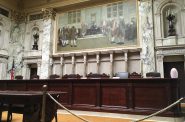Political Storm Brewing Over Redistricting
A life-or-death issue for politicians, and a call for IT geeks.
![Wisconsin State Capitol. Photo by Rosina Peixoto [CC BY-SA 3.0 (https://creativecommons.org/licenses/by-sa/3.0)], from Wikimedia Commons](https://urbanmilwaukee.com/wp-content/uploads/2015/07/Wisconsin_State_Capitol_in_Madison.jpg)
Wisconsin State Capitol. Photo by Rosina Peixoto (CC BY-SA 3.0), from Wikimedia Commons
Those storm clouds forming over Wisconsin’s Capitol have a name: Redistricting.
This is the summer-break calm before federal Census Bureau officials release new population numbers for the state, every municipality and demographic profiles of 1,409 census tracts. Those numbers will eventually — when lawyers for both political parties are done fighting and federal or state judges finally rule on the inevitable lawsuits — determine the boundaries of the state’s eight U.S. House districts, 33 state Senate and 99 Assembly districts for November 2022 elections. Each state Senate district includes three Assembly districts.
Reapportionment must be done every 10 years. It’s an eyes-glazing-over subject for most voters, struggling to put their families, careers and kids’ school lives back together after a cloistered Year of Living Covidly.
But it’s a life-or-death issue for career Capitol politicians. They worry about getting new regions to represent, potential primary challengers emboldened by new maps and being thrown into too-close-to-call districts, based on past voting patterns.
Republican legislators, working closely with then-Republican Gov. Scott Walker, tightly controlled the redrawing of Congressional and legislative maps 10 years ago. Republican legislators, for example, were sworn to secrecy before they could review their potential districts.
In lawsuits that followed the Legislature enacting, and Walker signing into law, the current district lines, experts testified that Republicans did a masterful job of making sure they kept control of the Legislature for the next five elections. Republicans control the Senate, 21-12, and the Assembly, 61-38.
In the end, federal judges only tinkered with the boundaries of two Milwaukee Assembly districts. Challenges to the GOP-drawn maps made it all the way to the U.S. Supreme Court, however.
This cycle, the redistricting process in Wisconsin is much different.
In every State of the State and budget speech since taking office in January 2019, Evers has called for rewriting state laws so a non-partisan panel of experts draws new district lines, which would then be forwarded to the Legislature to adopt or reject. The state Constitution requires that the Legislature ratify new lines. But, Evers and reformers insist, it doesn’t require that legislators also draw those lines.
Republicans’ answer: We, as the leaders chosen by voters statewide, have a constitutional duty to draw those maps that we aren’t giving up.
A second thing different than 10 years ago: the People’s Maps Commission that Evers created has given the cry for “fair maps” more public appeal and credibility, with 72% of state residents supporting non-partisan redistricting in the January 2019 Marquette University poll. The Commission has held public meetings across the state.
Third, the U.S. Supreme Court ruled that it could not adopt one national standard for political gerrymandering, although federal courts must still hear challenges to new districts based on race and other claims of discrimination. The U.S. Supreme Court ruling raised the importance of state courts — like the Wisconsin Supreme Court that just allowed Republican legislators to hire private attorneys with tax funds to prepare for future lawsuits — in deciding the legality of new maps.
One of the most interesting things about all that Census data: if you or someone you know is a computer and information technology geek, you can draw your own maps.
Jay Heck, executive director of Common Cause in Wisconsin, one of several groups pushing for an independent nonpartisan panel to recommend district lines to the Legislature – the system that exists in Iowa – recently told reform advocates to assist “the effort to draw your own voting map of your community” for the People’s Maps Commission.
“These maps could then be used as alternatives to the partisan voting maps Republicans in the Legislature have vowed to draw,” Heck added.
The People’s Maps Commission website offers a similar challenge: “Submit your map.”
Steven Walters started covering the Capitol in 1988. Contact him at stevenscotwalters@gmail.com
If you think stories like this are important, become a member of Urban Milwaukee and help support real, independent journalism. Plus you get some cool added benefits.
More about the Gerrymandering of Legislative Districts
- Without Gerrymander, Democrats Flip 14 Legislative Seats - Jack Kelly, Hallie Claflin and Matthew DeFour - Nov 8th, 2024
- Op Ed: Democrats Optimistic About New Voting Maps - Ruth Conniff - Feb 27th, 2024
- The State of Politics: Parties Seek New Candidates in New Districts - Steven Walters - Feb 26th, 2024
- Rep. Myers Issues Statement Regarding Fair Legislative Maps - State Rep. LaKeshia Myers - Feb 19th, 2024
- Statement on Legislative Maps Being Signed into Law - Wisconsin Assembly Speaker Robin Vos - Feb 19th, 2024
- Pocan Reacts to Newly Signed Wisconsin Legislative Maps - U.S. Rep. Mark Pocan - Feb 19th, 2024
- Evers Signs Legislative Maps Into Law, Ending Court Fight - Rich Kremer - Feb 19th, 2024
- Senator Hesselbein Statement: After More than a Decade of Political Gerrymanders, Fair Maps are Signed into Law in Wisconsin - State Senate Democratic Leader Dianne Hesselbein - Feb 19th, 2024
- Wisconsin Democrats on Enactment of New Legislative Maps - Democratic Party of Wisconsin - Feb 19th, 2024
- Governor Evers Signs New Legislative Maps to Replace Unconstitutional GOP Maps - A Better Wisconsin Together - Feb 19th, 2024
Read more about Gerrymandering of Legislative Districts here
The State of Politics
-
RNC Brings Fame to Gen Z Party Leader
 Jul 15th, 2024 by Steven Walters
Jul 15th, 2024 by Steven Walters
-
Wisconsin’s Republican Roots Run Deep
 Jul 8th, 2024 by Steven Walters
Jul 8th, 2024 by Steven Walters
-
Feuding Supreme Court Justices Need a Break
 Jul 1st, 2024 by Steven Walters
Jul 1st, 2024 by Steven Walters





















Governor Evers is working more strategically to rebalance voting than the Biden Administration. It will be his legacy. The Supreme Court ruling allowing pre-lawyering using taxpayer money is a ridiculous, naked attempt to forestall the inevitable.